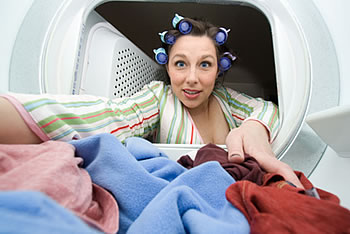Dryer vents are responsible for thousands of house fires each year. Failure to keep the vents clean and in good condition is one of the main causes of fire. However, problems can actually start from the moment the duct and vent is installed if the proper materials and installation techniques are not used.
 It is not reasonable to assume that the lint filter will catch all of the lint that is produced when you dry a load of clothes. In reality, it will only capture a small fraction of the lint that is produced. Over time the excess lint will be deposited in both the dryer and the duct-work. When this happens, the temperature of the air passing through the dryer duct will rise due to restricted airflow. This higher temperature can cause the lint (or the dryer itself) to catch fire.
It is not reasonable to assume that the lint filter will catch all of the lint that is produced when you dry a load of clothes. In reality, it will only capture a small fraction of the lint that is produced. Over time the excess lint will be deposited in both the dryer and the duct-work. When this happens, the temperature of the air passing through the dryer duct will rise due to restricted airflow. This higher temperature can cause the lint (or the dryer itself) to catch fire.Early Warning Signs Of Dryer Duct Trouble:
Any of the following could be a sign that the duct or vent needs to be cleaned, repaired, or replaced:
- The dryer takes longer than normal to dry a load of clothes
- Recently dried clothing feels hotter than usual
- Clothes remain damp after being run through a full drying cycle
The following are easy tests that can help determine if a problem exists:
- Turn the dryer on and proceed to the outdoor vent location. If the vent is not opening, or is not opening all the way, a blockage exists
- Visibly check for rips, tears, or holes in the vent material
- Check the lint termination area to see if lint is accumulating on surfaces underneath or around it
- Check for debris or lint behind or around the dryer
Proper Dryer Vent Installation
It is very important that the dryer is vented outside. It is not acceptable to vent into the basement or crawl space. Doing so could create higher humidity levels which could lead to an increase in moisture, mold growth and activity by water loving pests like rodents, insects and termites. Contrary to popular belief, it is not acceptable to vent your dryer into the home either. Some may consider doing this to provide extra warmth to the home during the winter months. Unfortunately, especially with gas dryers, a percentage of the air that is being distributed throughout the home may contain deadly carbon monoxide and other potentially hazardous byproducts of combustion.
Dryer Duct Materials
- Plastic and wire: Used frequently, but not the best choice. This type is meant to be used for bathroom venting and not for dryers. Neither plastic nor vinyl are UL approved for use as dryer duct material and can result in fires, especially with gas dryers which typically operate at higher temperatures. Use of either of these could result in voiding your dryer warranty
- Mylar: Similar to plastic, but slightly more resistant to being torn. Mylar vents are easy to crush, and the spiral wiring throughout can allow for rapid lint accumulation
- Semi-rigid aluminum: Functional and affordable, aluminum is a fine choice. It can be damaged, but will hold up well under normal use. The smooth metal discourages lint from accumulating
- Semi-rigid steel: More expensive than aluminum. Also a bit less pliable. Though installation may require a bit more work, steel is one of the best choices. Like aluminum, steel provides a smooth surface that reduces the chances of lint buildup
Booster Fans
Booster fans are marketed as a method of assisting the dryer in pushing exhaust products when the ducting is longer than normal. There use is common in high-rise condos and larger homes. Booster fans can cause problems when not installed correctly. In most cases they are used when the dryer duct exceeds the recommended length of 25'. Extending the dryer duct beyond its recommended length could create a problem with or without the use of a booster fan. Should you decide to use one, the booster unit should be installed no closer than 15' from the dryer. Any closer and the fan may draw in lint and clog up the appliance resulting in reduced performance and possible equipment failure.
Prevention is Key
Inspect the dryer vent system annually to ensure that it is in good condition. You should pay special attention if you own a gas dryer. In addition to presenting a fire hazard, carbon monoxide is another potential problem. Installation of a carbon monoxide detector in appropriate locations within the house could help prevent a tragedy. Should you notice problems, take care of them right away. As with many elements of the home, the best way to avoid problems is to take the time to complete the required maintenance according to manufacturers recommendations.


